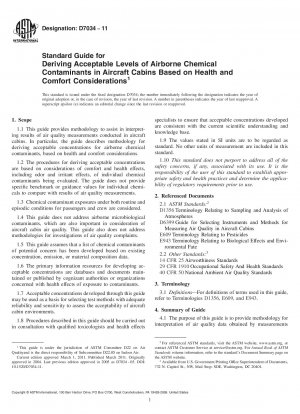ASTM D7034-11
Standard Guide for Deriving Acceptable Levels of Airborne Chemical Contaminants in Aircraft Cabins Based on Health and Comfort Considerations
- Standard No.
- ASTM D7034-11
- Release Date
- 2011
- Published By
- American Society for Testing and Materials (ASTM)
- Status
- Replace By
- ASTM D7034-18
- Latest
- ASTM D7034-18
- Scope
Although cabin air quality has been measured on numerous occasions and in many studies, there is very little guidance available for interpreting such data. Guidance for identifying contaminants and associated exposure levels that would cause concern in aircraft cabins is very limited. FAA Airworthiness Standards (14 CFR 25) constitute the only source of regulatory guidance that explicitly applies to the aircraft cabin environment. The FAA standards, however, define acceptable exposure limits for a limited number of chemical contaminants (ozone, carbon dioxide, and carbon monoxide). Another limitation of the FAA standards is that these are design standards only and are not operational standards; thus, once an aircraft is put in service these standards are not strictly applicable.
Measurements of aircraft cabin air quality often lead to a much larger list of volatile and semi-volatile organic chemicals of potential concern. Exposures to these chemicals, however, are largely unregulated outside of the industrial workplace.
An important feature of the aircraft cabin environment is that both passengers (public) and flight attendants (worker population) occupy it simultaneously. Therefore, workplace exposure guidelines cannot simply be extended to address exposures in aircraft cabin environment. Also, the length of flights and work shifts can vary considerably for flight attendants.
Contaminant levels of concern for the general public must account for the non-homogeneity of the population (for example, address sensitive individuals, the differences between passenger and crew activity levels, location, health status, personal microenvironment). Levels of concern associated with industrial workplace exposures typically consider a population of healthy adults exposed for 40 h per week (1). Consequently, exposure criteria developed to protect public health typically are more stringent than those for workers.
Given that the aircraft cabin environment must meet the needs of passengers as well as crew, a more stringent concentration level based upon the general population would protect both.
Aircraft cabin air quality must be addressed both during flight and on the ground because the conditions during flight are much different than when the aircraft is on the ground.
1.1 This guide provides methodology to assist in interpreting results of air quality measurements conducted in aircraft cabins. In particular, the guide describes methodology for deriving acceptable concentrations for airborne chemical contaminants, based on health and comfort considerations.
1.2 The procedures for deriving acceptable concentrations are based on considerations of comfort and health effects, including odor and irritant effects, of individual chemical contaminants being evaluated. The guide does not provide specific benchmark or guidance values for individual chemicals to compare with results of air quality measurements.
1.3 Chemical contaminant exposures under both routine and episodic conditions for passengers and crew are considered.
1.4 This guide does not address airborne microbiological contaminants, which are also important in consideration of aircraft cabin air quality. This guide also does not address methodologies for investigations of air quality complaints.
1.5 This guide assumes that a list of chemical contaminants of potential concern has been developed based on existing concentration, emission, or material composition data.
1.6 The primary information resources for developing acceptable concentrations are databases and documents maintained or published by cognizant authorities or organizations concerned with health effects of exposure to contaminants.
1.7 Acceptable concentrations developed through this guide may be used as a basis for selectin......
ASTM D7034-11 Referenced Document
- ASTM D1356 Standard Terminology Relating to Sampling and Analysis of Atmospheres*, 2024-04-19 Update
- ASTM D6399 Standard Guide for Selecting Instruments and Methods for Measuring Air Quality In Aircraft Cabins
- ASTM E609 Standard Terminology Relating to Pesticides
- ASTM E943 Standard Terminology Relating to Biological Effects and Environmental Fate
ASTM D7034-11 history
- 2018 ASTM D7034-18 Standard Guide for Deriving Acceptable Levels of Airborne Chemical Contaminants in Aircraft Cabins Based on Health and Comfort Considerations
- 2011 ASTM D7034-11 Standard Guide for Deriving Acceptable Levels of Airborne Chemical Contaminants in Aircraft Cabins Based on Health and Comfort Considerations
- 2005 ASTM D7034-05 Standard Guide for Deriving Acceptable Levels of Airborne Chemical Contaminants in Aircraft Cabins Based on Health and Comfort Considerations
- 2004 ASTM D7034-04 Standard Guide for Deriving Acceptable Levels of Airborne Chemical Contaminants in Aircraft Cabins Based on Health and Comfort Considerations
